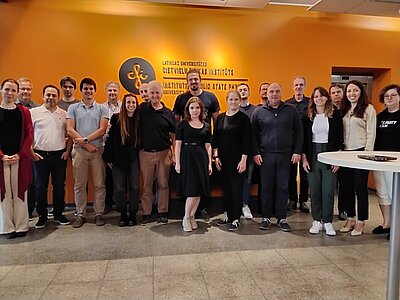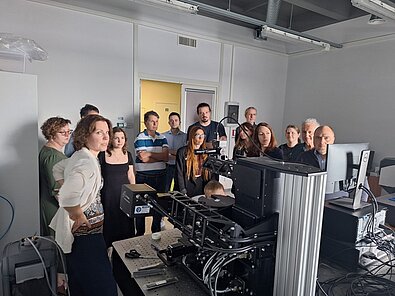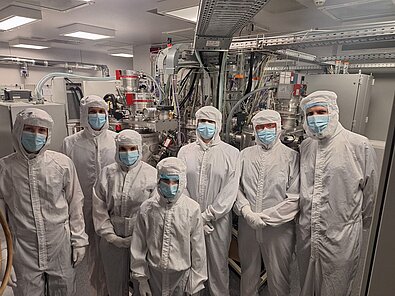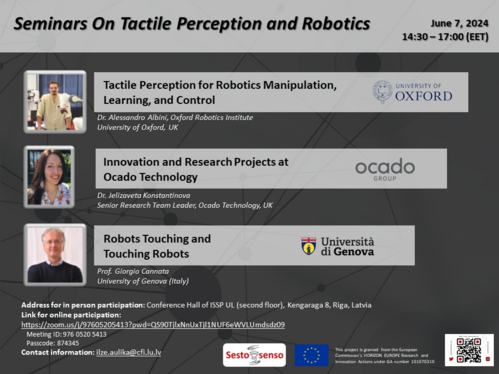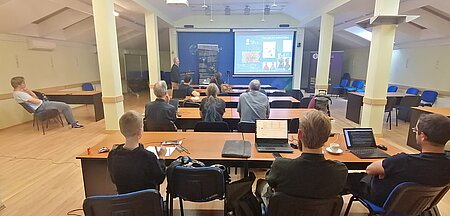Identification number: 101070310
Type: Horizon Europe
Project duration: 01.10.2022. – 30.09.2025.
Project manager: Prof. Giorgio Cannata, Department of Computer Science and Engineering, Bioengineering, Robotics and System Engineering at University of Genova in Italy.
Partners:
- University of Genova (UNIGE), Italy
- University of Zaragoza (UZ), Spain
- French-German Research Institute of Saint-Louis (ISL), France
- University of Ljubljana (UL), Slovenia
- Research Institutes of Sweden AB (RISE), Sweden
- Institute of Solid State Physics, University of Latvia (ISSP UL), Latvia
- FIAT Research Center (CRF), Italy
- Inertia Technology (IT), Netherlands
- Centre for Research and Technology HELLAS (CERTH), Greece
- University of Oxford (UOXF), United Kingdom
- Ocado Group (OCADO), United Kingdom
- University of Bologna (UNIBO), Italy
- University of Bolzano (UNIBZ), Italy
- Idiap Research Institute (IDIAP), Switzerland
Responsible person from ISSP UL: Ilze Aulika
Total funding:
4 157 054.50 Eur, 100% financed by European Commission
Project aim:
The aim of Sestosenso is a new embedded proximity and tactile sensing technology development for a robot body, providing unified proxy-tactile perception of an environment required to control the robot's actions and interactions safely and autonomously. The advancement of this sensing technology for collaborative robotics applications starts from the hardware and evolves up to the cognitive perception and control levels through specific electronics and software development.
Project summary:
Sestosenso develops technologies for the next generations of collaborative robots capable of self-adapting to different time-varying operational conditions and capable of safe and smooth adaptation from autonomous to interactive when human intervention is required either for collaboration or training/teaching. The project proposes a new sensing technology from the hardware and up to the cognitive perception and control levels, based on proximity and tactile sensors embedded in the robot body, providing unified proxy-tactile perception of an environment required to control the robot's actions and interactions safely and autonomously. Sestosenso is motivated by the industrial need to integrate workers with robots and the need for robots that could operate safely without out-of-the-robot infrastructure, thus reducing robot setup times and costs and increasing the flexibility of the shopfloor configuration. The Sestosenso technology is demonstrated by three Use Cases of industrial interest: cooperative assembly (automotive), handling and packaging (logistics), and cooperative harvesting (agriculture).
Expected scientific results:
- Hybrid sensor integration using printed electronic on conformable substrates
- Manufacturing of tactile sensors onto conformable substrates
- Optical tactile sensing
- Proximity technology for robot sensing
- Proxy-tactile data driven processing for control and human robot interaction
- Proxy-tactile human robot interaction and whole-body handling of objects
Tasks at ISSP, UL:
ISSP UL contributes to materials evaluation and multimodal transduction solutions selection, manufacturing processes evaluation and selection, sensor layout and electronic design and assessment of integrated sensor physical performance.
Furthermore, ISSP UL leads four tasks in Sestosenso project:
- Reference framework monitoring
- Modelling and evaluation of innovative optical tactile transducers
- Technical and Scientific Management
- Operational and Quality Procedures
ISSP UL is responsible for 2 deliverables and 1 milestone related to optical tactile sensor development.
Project progress information
Sestosenso Plenary Meeting
On June 6th and 7th, the Sestosenso Plenary Meeting took place at the ISSP UL. The event saw the participation of 27 individuals attending in person, along with 13 participants joining online. The meeting brought together representatives from a consortium of 14 partners spanning 10 countries.
Lab Tour
During the Sestosenso Plenary Meeting, participants had the opportunity to visit several ISSP UL laboratories. The tour included a visit to the Clean Room facility, which spans 650 m² and meets ISO 6-8 standards. This facility is equipped with state-of-the-art technologies for thin film fabrication, micro and nano-structuring, and lithography. Additionally, it houses advanced material characterization tools such as scanning electron microscope (SEM) and transmission electron microscope (TEM).
In the Laboratory of Spectroscopy, visitors were introduced to various state-of-the-art spectroscopy technologies. These included Raman spectroscopy, laser ablation, luminescence techniques, as well as instruments such as the spectrophotometer and spectroscopic ellipsometer, which are utilized in the Sestosenso project.
Seminars
The Sestosenso Plenary Meeting on June 7 at ISSP UL concluded with a seminar session focused on tactile perception and robotics.
Three lectures were delivered by experts from the University of Oxford, OCADO Technology, and the University of Genoa.
Sestosenso kick-off meeting | October 19, 2022.
Sestosenso kick-off meeting took place in Genoa, Italy on October 6 and 7, 2022 with participation of 14 project partners. The meeting was organized by the project coordinator – University of Genoa. During the meeting, each partner presented their activities and role in the project. The planning of the main tasks for the first 6 months was carried out.
